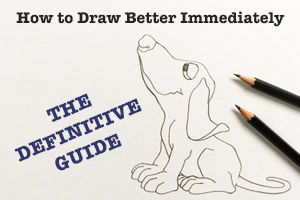
This is part 11 of the series How to Draw Better Immediately – The Definitive Guide.
Many people underestimate the extreme importance of comparing tones. However, during the process of making such comparisons, you may find yourself concerned with too many different aspects of the process. For example: sizes, angles, shadow-shapes, highlights and other such features.
Limit your focus
However, you must take care not to focus on too many things simultaneously, which can make you feel distressed, overwhelmed or frustrated – experiences which you want to avoid during the process of drawing. Rather, shade-in the desired shape first, by applying a light layer of HB pencil (or a mid-tone of colour if working in coloured pencil). Following this, you can then begin to develop the level of tone or colour in a separate process.
Whenever making comparisons of tone, you can squint to blur the shapes and simplify the image. This will help you to see the various areas of tone more easily.
Value Scales
It is also often valuable to refer to a value scale, which is a row of various levels of tone, from lightest to darkest. For complete beginners, the easiest method is to compare tones with only six tonal values, thus limiting the choices available.
The Theory of Light and Shade
Another really important tool that you can use to create accurate areas of tone in your artworks is the theory of light and shade, which has been handed down to us by the great masters of art. According to this theory, when there is only one main light source illuminating a form, this creates five major areas of light and shade.
These areas are referred to with the following terms:
- Full Light Area
- Shadow Edge
- Half-tones
- Reflected Light
- Cast Shadows
But this is just a taster: we will get deeper into all of this during shading sections of the Complete Online Drawing Course.
So, when it comes to the skill of comparing tones, what sorts of questions are you likely to ask yourself when using the Artist’s Language?
- “Is this the darkest part of my drawing?”
- “What other areas represent the darkest part of the drawing?”
- “Where is the light coming from?”
- “What shapes would be in this shadow area if I could see this part of the photograph more clearly?”
- “Is this the exact place where the light would first leave the form? If so, the shadow-edge must be placed there, because the photograph has obviously flattened the form.”
Other examples of statements which you might make to yourself:
- “Wow, look how the light shines off the surface of this object – this really is the lightest part.”
- “This handle is actually a giant curved cylinder! I can shade that shape already, because I learned all about shading cylinders earlier in the course. Easy peasy!”
- “Hey, this little knob on the lid of my kettle is just a sphere! We have already learnt how to shade spheres, so now all I have to do is apply this to the knob.”
- “My goodness, this column fold is really just a heap of cones. They may be unusually long, thin and narrow cones, but they are still cones at the end of the day.. Yippee! I have already learnt how to shade cones!”
- “Hmmmm….this downward-curving scalloped edge on my little urn is actually a curved cylindrical form, sort of like a pipe or rope. I can just apply the knowledge I have learned from shading cylinders; and instead of shading a straight line, I will just curve it!”
Next: Comparison of Spaces


